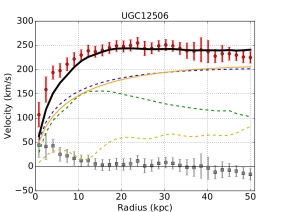A little help to keep galaxies together
 What keep stars and gas together in a galaxy? The force of gravity, of course. But what originates this gravity? Since the 70s, we know that the combined gravity pull of stars, gas, and dust is not sufficient to keep galaxies rotating around their center: we need dark matter. Actually, we need on average at least five-ten times more dark matter than ordinary atoms. Stars and gas move in fact so fast that without the help of dark matter they would not stay bound to the galaxy, but would flee away. This bold conclusion has been challenged many times. Already in 1963, Arrigo Finzi, then at the University of Rome, realized that a small modification of Newton’s gravity would be a simple way to get rid of dark matter. His proposal had few followers, but it has been sporadically renewed under various guises over the subsequent fifty years.
What keep stars and gas together in a galaxy? The force of gravity, of course. But what originates this gravity? Since the 70s, we know that the combined gravity pull of stars, gas, and dust is not sufficient to keep galaxies rotating around their center: we need dark matter. Actually, we need on average at least five-ten times more dark matter than ordinary atoms. Stars and gas move in fact so fast that without the help of dark matter they would not stay bound to the galaxy, but would flee away. This bold conclusion has been challenged many times. Already in 1963, Arrigo Finzi, then at the University of Rome, realized that a small modification of Newton’s gravity would be a simple way to get rid of dark matter. His proposal had few followers, but it has been sporadically renewed under various guises over the subsequent fifty years.
A relatively simple way to modify gravity assumes that it is actually the sum of two forces: beside standard Einstein’s gravity, of which Newton’s theory is but an approximation, a new force operates, but only up to a given distance. This new force, called a fifth force because we know already four fundamental forces in nature, is then characterized only by a strength, just like a new gravitational constant G, and a range.
Although many people tried to entirely replace dark matter with the fifth force, in a recent paper we asked ourselves whether dark matter and the fifth force can actually coexist. So we analyzed 40 galaxies from a recent observational catalog and compared their rotation curves with a model that contains stars and gas, distributed in a central bulge and in a disk, plus a dark matter spherical halo, plus the fifth force. We found that the fifth force can give a substantial help to dark matter, provided the new force is roughly one-third of the gravitational one, and its range is around 6 kiloparsecs, a bit shorter than the distance from the Sun to the Milky Way’s center. With this help, dark matter can be 20% less abundant than without. We cannot say if this conclusion works for all galaxies, nor what happens if we consider different models for the dark matter halos, but at least it makes such further investigation quite more exciting.
So we cannot replace dark matter; but we find that an extra force can give a little help to keep galaxies together.
